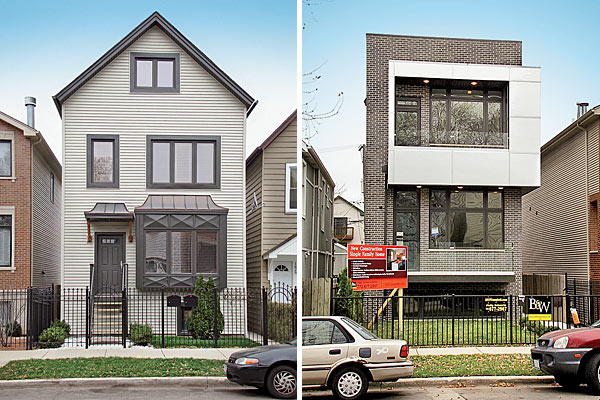
Ewa Jakubik and Jagoda Krypla fixed up this Humboldt Park house (left) and then sold it for a 27 percent profit. Jakubik and Krypla paid about $235,000 for this West Town residence (right), completely overhauled the interior, and now have the house listed at $799,000.
House flipping died with the housing boom, right? Wrong. With banks unloading foreclosures at rock-bottom prices, some savvy investors have changed tactics: Focus exclusively on foreclosures, fix them up, and resell them at a profit much higher than you might think.
Consider Ewa Jakubik and Jagoda Krypla. Their first project was a foreclosed two-flat in Austin in 2008. They paid less than $50,000 for the property, Jakubik says, spent another $60,000 to make the place habitable, and then sold it for $175,000—a 59 percent profit.
Since then, buying foreclosures has become more popular, sending up the purchase price for some flippable properties by about 10 percent, according to Jakubik’s estimate. Still, there is money to be made in that real-estate niche. And with 20 such projects under their collective belts, the successful partners have some tips for would-be foreclosure flip artists.
• It’s all about the math. When evaluating a potential deal, add the purchase price to the amount it will realistically take to turn the place into a desirable property. (Establish relationships with reliable contractors who can estimate the cost of turning a place around and have the experience to deliver the goods while sticking to a budget.) Only if the total comes in at least 20 percent below the present-day market price of similarly sized homes in the neighborhood is it worth going forward (though fix-up time and the state of the neighborhood could boost that percentage upward). That’s the formula the partners followed in Humboldt Park, where they paid $130,000 for a single-family home with a rentable coach house, which Jakubik remembers as a “complete disaster.” But after spending about $200,000 to put the house right, they were able to sell it for $421,000—a 27 percent profit.
• Don’t ignore homes in poor condition. They are likely to sell at a bargain price, and they can actually be less costly to fix up than better-maintained homes. If a house is missing drywall, for instance, the flipper wouldn’t have to pay to pull it down before installing the replacement. There is one exception to this rule. “We would never buy anything with a damaged foundation,” Jakubik says. “Fixing that costs too much.”
• Shop often, but buy seldom. Jakubik estimates that she and Krypla have walked through about 200 houses, or ten for every one they bought. And be prepared to walk away from a sweet deal if the bidding becomes too intense.
• Stick with houses. Philip Schwartz of Baird & Warner, Jakubik and Krypla’s real-estate agent, notes that the buyer of a fixed-up foreclosure has a better shot at getting a mortgage on a house than on a condo. “Lending doesn’t happen if there are too many rentals or too many foreclosures [among] the other units in a [condo] building,” he says.
• Factor in some flops. Even with the most careful planning, flipping carries a risk. In North Austin, Jakubik and Krypla paid $70,000 for a home they expected to resell for at least $170,000. Local gang activity dampened buyer interest, and they ended up taking a loss—Jakubik won’t specify how much—when they sold the house for $150,000.
Send tips about home sales to dennis@rodkin.com.
Photography: Todd Urban


